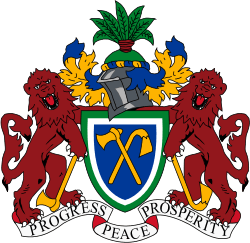Gambia Colony and Protectorate
| Gambia Colony and Protectorate | ||||||||
| ||||||||
| ||||||||
 | ||||||||
| Capital | Bathurst | |||||||
| Languages | English (official) Mandinka, Fula, Wolof widely spoken | |||||||
| Religion | Christianity, Sunni Islam, Serer | |||||||
| Government | Not specified | |||||||
| Monarch | ||||||||
| • | 1821–1830 | George IV (first) | ||||||
| • | 1952–1965 | Elizabeth II (last) | ||||||
| Governor | ||||||||
| • | 1829–1830 | Alexander Findlay (first) | ||||||
| • | 1962–1965 | John Warburton Paul (last) | ||||||
| Prime Minister | ||||||||
| • | 1962–1965 | Dawda Jawara | ||||||
| History | ||||||||
| • | Establishment | 17 October 1821 | ||||||
| • | Independence as The Gambia | 18 February 1965 | ||||||
| Area | ||||||||
| • | 1965 | 11,295 km² (4,361 sq mi) | ||||||
| Population | ||||||||
| • | 1901 est. | 90,404 | ||||||
| • | 1931 est. | 199,520 | ||||||
| • | 1963 est. | 315,486 | ||||||
| Currency | pound sterling (to 1912) British West African pound (1912–65) | |||||||
| ||||||||
Part of a series on the |
|---|
| History of the Gambia |
 |
| Chronological |
|
|
The Gambia Colony and Protectorate was part of the British Empire in the New Imperialism era. The colony was the immediate area surrounding Bathurst, and the protectorate the inland territory situated around the Gambia River, which was declared in 1894. The foundation of the colony was Fort James and Bathurst, where British presence was established in 1815 and 1816, respectively. For various periods in its existence it was subordinate to the Sierra Leone colony, however by 1888 it was a colony in its own right with a permanently appointed Governor.
The boundaries of the territory were an issue of contention between the British and French authorities due to the proximity to French Senegal;.[1] this was resolved in 1889. Additionally, on numerous occasions the British government had attempted to exchange it with France for other territories, such as on the upper Niger River.[2]
The colony ended in 1965 when Gambia became an independent state within the Commonwealth of Nations,[3] with Dawda Jawara as Prime Minister.
Economy
The economy of the Gambia, like other African countries at the time, was very heavily orientated towards agriculture. Reliance on the groundnut became so strong that it made up almost the entirety of exports, making the economy vulnerable. Groundnuts were the only commodity subject to export duties[4] The export duties resulted in the illegal smuggling of the product to French Senegal.
Attempts were made to increase production of other goods for export: the Gambian Poultry Scheme pioneered by the Colonial Development Corporation aimed to produce twenty million eggs and one million lb of dressed poultry a year. The conditions in the Gambia proved unfavourable and typhoid killed much of the chicken stock, drawing criticism to the Corporation.[5]
Transport
The River Gambia was the principal route of navigation and transport inland, with a port at Bathurst. The road network was mainly concentrated around Bathurst, with the remaining areas largely connected by dirt roads.
The only airport was at Yundum, built in World War II.[6] Post war it was used for passenger flights. Both British South American Airways and the British Overseas Airways Corporation had services, the former moving its service to Dakar, which had a concrete runway (as opposed to pierced steel planking).[7] The airport was rebuilt in 1963 and the building is still in use today.
Independence
In anticipation of independence, efforts were made to create internal self-government. The 1960 Constitution created a partly elected House of Representatives, with 19 elected members and 8 chosen by the chiefs. This constitution proved flawed in the 1960 elections when the two major parties tied with 8 seats each. With the support of the unelected chiefs, Pierra Sarr N'Jie of the United Party was appointed Chief Minister. Dawda Jawara of the People's Progressive Party resigned as Minister of Education, triggering a Constitutional Conference arranged by the Secretary of State for the Colonies.[8]
The Constitutional Conference paved the way for a new constitution that granted a greater degree of self-government and a House of Representatives with more elected members. Elections were held in 1962, with Jawara's Progressive Party securing a majority of the elected seats. Under the new constitutional arrangements, Jawara was appointed Prime Minister: a position he held until it was abolished in 1970.
Following agreements between the British and Gambian Governments in July 1964, Gambia became independent on 18 February 1965.
See also
References
- ↑ "Hansard HC Deb 18 August 1887, vol 319, cols 944–955".
- ↑ Thomas Pakenham (1991), The Scramble for Africa. London: Abacus. p. 675
- ↑ Gambia Independence Act 1964, c. 93
- ↑ "Hansard HC Deb 25 March 1959, vol 602, cols 1405–1458".
- ↑ "Hansard HC Deb 13 March 1951, vol 485, cols 1317–1375".
- ↑ "Yundum". Britannica Online encyclopedia. Retrieved 10 August 2012.
- ↑ "Hansard HC Deb 29 January 1947, vol 432, cols 202".
- ↑ "History of the Independence Movement". Gambia Information Site. 10 August 2012.
External links
| Wikimedia Commons has media related to British Gambia. |
.svg.png)
